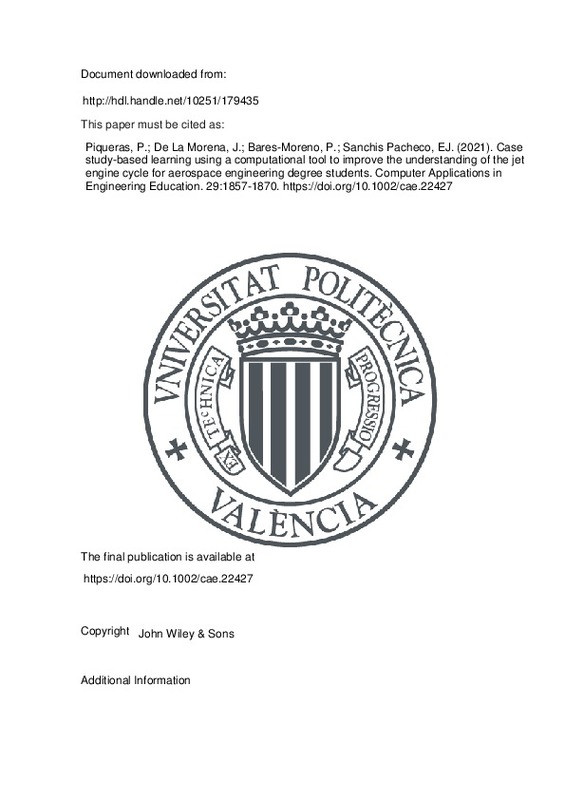JavaScript is disabled for your browser. Some features of this site may not work without it.
Buscar en RiuNet
Listar
Mi cuenta
Estadísticas
Ayuda RiuNet
Admin. UPV
Case study-based learning using a computational tool to improve the understanding of the jet engine cycle for aerospace engineering degree students
Mostrar el registro sencillo del ítem
Ficheros en el ítem
| dc.contributor.author | Piqueras, P.
|
es_ES |
| dc.contributor.author | De La Morena, Joaquín
|
es_ES |
| dc.contributor.author | Bares-Moreno, Pau
|
es_ES |
| dc.contributor.author | Sanchis Pacheco, Enrique José
|
es_ES |
| dc.date.accessioned | 2022-01-10T19:31:57Z | |
| dc.date.available | 2022-01-10T19:31:57Z | |
| dc.date.issued | 2021-11-11 | es_ES |
| dc.identifier.issn | 1061-3773 | es_ES |
| dc.identifier.uri | http://hdl.handle.net/10251/179435 | |
| dc.description.abstract | [EN] In the current paper, a methodology combining a case study with a computational tool for aerospace engineering students is presented and discussed. The aim of this methodology is to improve the understanding of jet engine's operation through their thermodynamic cycle analysis, particularly focused on the effects of the main boundary conditions for an aircraft engine: altitude and flight velocity (or Mach). Additionally, the organization of the methodology as a case study performed in groups helps to facilitate student engagement, as well as the development of soft skills, such as teamwork ability. The experience of this methodology over the last 5 years shows that the activity is generally well perceived by the students, and also that there is a correlation between the engagement in this activity and the overall results achieved in the subject, confirming that the methodology helps to improve students' comprehension of the concepts behind engine performance. However, a few points of improvement for the near future are identified. | es_ES |
| dc.description.sponsorship | Universitat Politecnica de Valencia, Grant/Award Number: E-20-21/204 | es_ES |
| dc.language | Inglés | es_ES |
| dc.publisher | John Wiley & Sons | es_ES |
| dc.relation.ispartof | Computer Applications in Engineering Education | es_ES |
| dc.rights | Reserva de todos los derechos | es_ES |
| dc.subject | Altitude | es_ES |
| dc.subject | Brayton | es_ES |
| dc.subject | Case study | es_ES |
| dc.subject | Mach | es_ES |
| dc.subject | Thermodynamics | es_ES |
| dc.subject | Thrust | es_ES |
| dc.subject | Turbojet | es_ES |
| dc.subject.classification | MAQUINAS Y MOTORES TERMICOS | es_ES |
| dc.subject.classification | INGENIERIA AEROESPACIAL | es_ES |
| dc.title | Case study-based learning using a computational tool to improve the understanding of the jet engine cycle for aerospace engineering degree students | es_ES |
| dc.type | Artículo | es_ES |
| dc.identifier.doi | 10.1002/cae.22427 | es_ES |
| dc.relation.projectID | info:eu-repo/grantAgreement/UPV//E-20-21%2F204/ | es_ES |
| dc.rights.accessRights | Abierto | es_ES |
| dc.contributor.affiliation | Universitat Politècnica de València. Departamento de Máquinas y Motores Térmicos - Departament de Màquines i Motors Tèrmics | es_ES |
| dc.description.bibliographicCitation | Piqueras, P.; De La Morena, J.; Bares-Moreno, P.; Sanchis Pacheco, EJ. (2021). Case study-based learning using a computational tool to improve the understanding of the jet engine cycle for aerospace engineering degree students. Computer Applications in Engineering Education. 29:1857-1870. https://doi.org/10.1002/cae.22427 | es_ES |
| dc.description.accrualMethod | S | es_ES |
| dc.relation.publisherversion | https://doi.org/10.1002/cae.22427 | es_ES |
| dc.description.upvformatpinicio | 1857 | es_ES |
| dc.description.upvformatpfin | 1870 | es_ES |
| dc.type.version | info:eu-repo/semantics/publishedVersion | es_ES |
| dc.description.volume | 29 | es_ES |
| dc.relation.pasarela | S\449282 | es_ES |
| dc.contributor.funder | Universitat Politècnica de València | es_ES |
| dc.subject.ods | 07.- Asegurar el acceso a energías asequibles, fiables, sostenibles y modernas para todos | es_ES |







![[Cerrado]](/themes/UPV/images/candado.png)

